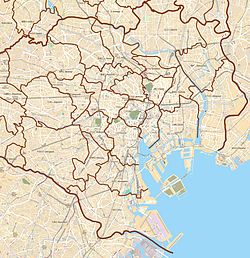world.wikisort.org - Japan
Harumi (晴海) is a district of Chūō, Tokyo. The district contains five chōme (subdivisions), and the postal code is 104-0053.[2] Harumi is located on reclaimed land, created by dropping earth and sediment generated from expanding Tokyo Bay. The construction took place starting in the middle of the Meiji era and was completed early in the Showa era. before an official name was decided for the district, it was called Tsukishima No. 4.
This article may be expanded with text translated from the corresponding article in Japanese. (May 2019) Click [show] for important translation instructions.
|
Harumi
晴海 | |
|---|---|
District | |
 Harumi passenger ship terminal | |
| Coordinates: 35°39′34.83″N 139°47′5.64″E | |
| Country | |
| City | |
| Ward | |
| Population (September 1, 2019)[1] | |
| • Total | 16,120 |
| Time zone | UTC+9 (JST) |
| Postal code | 104-0053[2] |
| Area code | 03[3] |
The district was designated to host celebrations of the 2600th anniversary of the founding of Japan (by the mythical emperor Jimmu), but celebrations (scheduled to take place in 1940) were canceled due to Japan being at war with the Republic of China and the United States.
The Olympic Village for the 2020 Olympics (postponed to 2021) was located in the 5th chōme of Harumi, at Harumi Futo.
History
Chronology
- April 1929 – Landfill has been completed as Tsukishima No. 4 (Tokyo Bay Landfill No. 4).
- July 15, 1937 – Named the area as Harumi-cho by open recruitment by local residents.
- March 15, 1947 – Nihonbashi Ward and Kyobashi Ward merge to form Chuo Ward.
Demographics
In total, the district has 7,377 households and 16,120 people.
The number of households and population of each chōme as of December 1, 2019 are as follows:[4]
| Chome | Number of households | population |
|---|---|---|
| Harumi 1-chome | 1,889 households | 4,074 people |
| Harumi 2-chome | 2,520 households | 6,016 people |
| Harumi 3-chome | 2,089 households | 4,179 people |
| Harumi 4-chome | 80 households | 112 people |
| Harumi 5-chome | 799 households | 1,739 people |
| Total | 7,377 households | 16,120 people |
Education
Public elementary and junior high schools are operated by Chuo City Board of Education.
Harumi is zoned to Tsukishima Daisan (Tsukishima No. 3) Elementary School (月島第三小学校) and Harumi Junior High School (晴海中学校).[5]
References
- "町丁目別世帯数男女別人口". 中央区. 2019-09-03. Retrieved 2019-09-23.
- "郵便番号". 日本郵便. Retrieved 2019-09-30.
- "市外局番の一覧". 総務省. Retrieved 2017-12-31.
- "令和3年 中央区ホームページ". www.city.chuo.lg.jp. Retrieved 2021-08-06.
- "区立学校一覧". Chuo City. Retrieved 2022-10-08.
External links
Другой контент может иметь иную лицензию. Перед использованием материалов сайта WikiSort.org внимательно изучите правила лицензирования конкретных элементов наполнения сайта.
WikiSort.org - проект по пересортировке и дополнению контента Википедии




